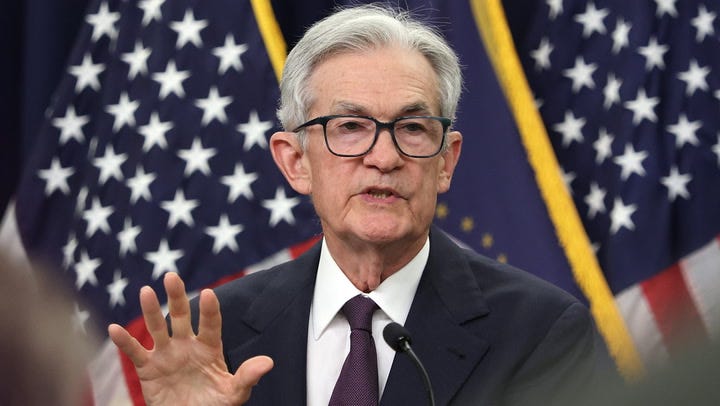
Trump calls for Fed rate cuts defying Powell’s moves
The Federal Reserve kept its benchmark interest rate unchanged on June 18, defying President Trump’s calls for immediate cuts despite increasing political pressure.
Cheddar
In his stinging monthslong campaign to badger Federal Reserve Chair Jerome Powell into lowering interest rates, President Donald Trump has relied on a variety of arguments.
He’s pointed to the European Central Bank’s two percentage points of rate cuts and a report showing weakening private-sector job growth.
Most recently, he has cited a claim that Fed’s refusal to slash its key rate is costing the federal government hundreds of billions of dollars a year in interest payments on its debt.
Is Trump right? In the short term, analyst say, lower rates likely would save the government money. But that comes with some big caveats.
What is Trump saying about Fed rates?
This week, on his Truth Social site, Trump shared a handwritten note he wrote to Powell. “You are, as usual, ‘Too Late,” he wrote. “You have cost the USA a fortune and continue to do so. You should lower the interest rate by a lot! Hundreds of billions of dollars being lost! No inflation.”
Attaching a list of central bank interest rates, Trump drew two arrows pointing to a rate between Japan’s 0.5% and the 1.75% shared by Denmark, Seychelles and Thailand. That suggests Trump thinks the Fed should chop its key short term interest rate by a whopping 3 percentage points or so, from a range of 4.25% to 4.5% to about 1.25%.
Last week, calling Powell a “numbskull,” a “dumb guy,” and a “Trump Hater,” the president said a 3 point rate cut would save the government $900 billion a year in interest payments.
What will happen when the Fed cuts rates?
Broadly speaking, “If the Fed were to lower rates… it would indeed likely lower the cost of Treasury debt,” said John Canavan, lead financial market analyst at Oxford Economics.
“Lower rates are probably going to save the government money,” added Wells Fargo senior economist Mike Pugliese.
However, Trump appears to be overstating the savings, said Gbenga Ajilore, chief economist of the Center on Budget and Policy Priorities.
What is the main job of the Federal Reserve?
The Fed is an independent agency and its job is not to reduce interest rates to make borrowing cheaper for the federal government, Canavan and Pugliese said.
Under its two congressional mandates, the central bank reduces rates to lower borrowing costs for Americans and bolster a sluggish economy. It hikes rates or keeps them high longer to head off inflation.
How much did the Fed reduce interest rates?
The Fed slashed its key rate by a percentage point late last year after a pandemic-related inflation spike eased but has paused since.
In testimony before Congress in late June, Powell agreed the Fed’s preferred inflation measure, now at 2.3%, has dropped closer to its 2% goal. But he said Trump’s tariffs are expected to spark a “meaningful increase in inflation” in coming months and officials want to wait and see how that plays out before reducing rates again.
Putting aside the Fed’s mandates, it’s reasonable to wonder if a Fed rate decrease would save the government lots of money at a time the national debt tops $36 trillion. Trump’s “big, beautiful” budget bill is projected to add $3.3 trillion to the red ink, according to the Congressional Budget Office.
It’s not clear how Trump came up with the $900 billion and a White House spokesperson did not return an email seeking an explanation.
But Trump told Fox News on June 29 that the government must refinance $9 trillion in debt coming due this year. The Treasury Department’s total annual interest payments on all its debt are projected to grow to about $1 trillion in fiscal 2026, according to the Committee for a Responsible Federal Budget.
Just taking the $9 trillion that must be refinanced, interest rates that have risen sharply since the U.S. first issued the debt could cost the government as much as an additional $300 billion a year, Axel Funhoff, a corporate finance professor at Antwerp Management School in Belgium, wrote in a LinkedIn article earlier this year.
That suggests the U.S. Treasury could save more than $100 billion a year if the Fed cut its key rate by 3 percentage points. But that would be a massive cut, unprecedented during a time the economy is generally stable and far larger than the percentage point drop Fed officials estimate they’ll approve through gradual quarter-point decreases by 2027.
Also, large rate cuts could have unintended consequences for U.S. debt costs.
How do interest rates impact the cost of borrowing?
The Fed’s benchmark interest rate is a short-term rate and so it directly affects short-term assets such as Treasury bills with terms up to a year, Canavan said. Thus, a quarter-point Fed rate cut, he said, likely would have a similar affect on such Treasury bills.
But only about 20% of the Treasury’s outstanding debt is in such short-term securities, though almost all new debt is short term because long-term rates are high, Canavan said.
More than half the debt is in 2- to 10-year Treasury bonds, he said, and the rest is in longer term securities of up to 30 years, floating rate bonds and other assets. Those securities are affected by Fed rate moves because they influence investor expectations about future Fed actions, Canavan said.
But only partly. Because investors hold those assets for long periods of time, they’re mostly affected by factors such as the economic outlook, inflation expectations, the size of the federal deficit and investors’ confidence in Treasury bonds as a safe and reliable investment, Canavan said.
“If the market decides the Fed is cutting too much” to satisfy Trump or lower borrowing costs for the U.S. Treasury, investors likely would worry about a future inflation spike, causing them to demand higher rates to lend the government money, Canavan said. Otherwise, he said, inflation could erode the value of their bonds.
In that case, “You may see long term rates rise” even though the Fed is reducing its short term rate, he said.
In other words, by causing investors to question the Fed’s independence, Trump’s calls for rate cuts could result in the outcome he least desires, assuming the Fed acquiesced to his pleas.
“Monetary policy only works if the Fed has credibility,” Ajiilore said.
Canavan said it’s difficult to say if government savings from a drop in short-term rates – which must be refinanced more frequently – would more than offset any losses from a rise in long-term rates.
Pugliese said the U.S. Treasury likely still would come out ahead in the near term. But “over the long term it would probably cost money,” he said.
By contrast, if the Fed reduces rates twice later this year and once in 2026 as officials expect, investors would be more confident that officials are making the moves because inflation is easing and not because of political pressure.
The result likely would be lower short-term and long-term rates, and lower interest payments for the government.








